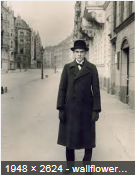This tutorial is for beginners to intermediate. The focus is on:
- Creating an image for Web use
- Placing images
- Using various selection tools
- Creating Layer masks
- Using refine edge function
- Work with Layer Blending Modes
Create an Image for Web
Start off Photoshop. Create a New Document (Ctrl+N). Choose:
Preset: Web
Size: 800 x 600 (px)
Resolution: 72ppi

Placing Image
First select a close-up photo of texture from here: Link to Images! Select one and save it to your folder and back in Photoshop place the image in your file: File>Place and create a size that covers most of the background.
Do a Google Image Search for German photographer August Sander. Refine your search to large images (this can be done in Search Tools>Size>Large).
Alternatively click on here: Google Search for August Sander.

Save the image in your folder and return to Photoshop. Place the image in your file: File>Place and create a size in which the man stands in the foreground with his face being placed about 3/4 in the top.Hit Enter to accept.
Using various selection tools
Use various Selection Tools to select the background behind the man. See this tutorial for more information on Selection Tools.

Creating Layer masks
After selecting the entire background create a Layer Mask to hide the background. See this Photoshop Essential Tutorial on How to create a Layer Mask.

Using refine edge function
Use a Macro option on your camera to allow for good detail for the close-ups.
Use the Refine Mask function (Shortcut in CS6 is Ctrl+Shift+R) and smoothen out the mask edge.
Work with the background and reduce it to the size of a rectangle:
- Make a selection with the Rectangular Marquee
- Apply a Layer Mask to the selection
Work With Layer Blending Modes
Last play with the Layer Blending Modes. Create a result like this one:







